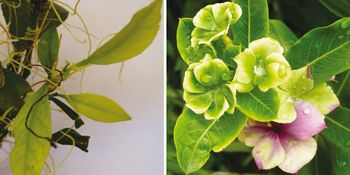Phytoplasma phoenicium
| Literature database |
|---|
| 42 articles sorted by: |
| • year (recent ones first) |
| • research topics |
| • countries/regions |
| • host plants |

Author(s): Júlio César Barbosa et al.
Source: Tropical Plant Pathology (2012) vol. 32 (2)
Candidatus Phytoplasma phoenicium Verdin et al. (2003) - (almond witches'-broom phytoplasma)
This phytoplasma is found mainly in the Near East, but has been also reported from India, Italy and parts of Central America. It causes diseases on fruit and nut trees of the genus Prunus, but also affects other crops. Pigeon pea witches'-broom phytoplasma is a closely related phytoplasma. In the Near East and in Italy, almonds, peach and nectarine are usually most seriously affected.
The main symptoms on Prunus are shoot proliferation on the main trunk, roots or branches. Witches’ broom symptoms may also appear, with small and yellowing leaves. Further, leaf roll, stunting and dieback symptoms have been described. Affected trees initially have a reduced fruit production, which stops completely after about one year.
Several plant-sucking insects have been identified as vectors like the leafhopper Asymmetrasca decedens and species of the planthopper genus Tachycixius.
The phytoplasma has been assigned to subgroup B of the 16SrIX phytoplasma group. Variant strains have been also assigned to subgroup D and other subgroups.
| Vernacular names | |
|---|---|
| • English: | almond lethal disease pigeon pea witches’-broom phytoplasma almond witches’-broom phytoplasma |
| • Français: | balai de sorcière de l'amandier |
For a review see Mehle et al. (2021).